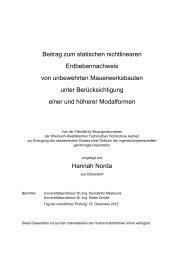Ion Beam Treatment of Functional Layers in Thin-Film Silicon Solar ...
Ion Beam Treatment of Functional Layers in Thin-Film Silicon Solar ...
Ion Beam Treatment of Functional Layers in Thin-Film Silicon Solar ...
Create successful ePaper yourself
Turn your PDF publications into a flip-book with our unique Google optimized e-Paper software.
5 <strong>Ion</strong> beam treatment <strong>of</strong> the glass surface<br />
Table 5.6: XPS measurement results on a reference and three different ion beam treated<br />
Corn<strong>in</strong>g glass. The values <strong>in</strong> the table are the atomic percentage (at%) normalized<br />
to 100 with Rel. error <strong>of</strong> ± 15%. The m<strong>in</strong>imum measurable range was<br />
1 at%. The four substrates were used for prepar<strong>in</strong>g ZnO:Al films as shown<br />
<strong>in</strong> Fig. 5.2. The rms roughness <strong>of</strong> the four ZnO:Al films are given <strong>in</strong> the last<br />
row.<br />
Glass Ref. Ar treated O 2 treated Ar/O 2 treated<br />
C 19.9 33 32.3 27.8<br />
O 56 44 46.7 49.9<br />
Fe - 3.8 - 5.0<br />
Zn - 0.1 0.5 1.2<br />
Si 18.7 8.1 14.6 7.5<br />
Al 3.9 5.6 3.9 3.7<br />
Ca 0.9 2.3 0.9 2.0<br />
N 0.7 0.6 0.9 0.3<br />
P - 1.1 - 0.8<br />
Cl - 0.1 0.2 0.4<br />
Ar - 1.2 - 1.3<br />
rms roughness (nm)<br />
ZnO:Al films 4 12 34 44<br />
the ion beam pretreated samples s<strong>in</strong>ce the ion bombardment activated the surface. The<br />
percentage <strong>of</strong> O and Si were reduced, while Zn and Fe were added to the surface. Few<br />
Ar was implanted to the sample surface by Ar and Ar/O 2 bombardment. Additionally,<br />
slight changes were observed on Al, Ca, P, and Cl elements.<br />
On Ar ion beam treated glass surface, Fe contam<strong>in</strong>ation is severe (3.8 at%), but on<br />
O 2 ion beam treated glass surface, there is almost no Fe contam<strong>in</strong>ation (< 0.1 at%).<br />
Zn is observed on the three ion beam treated glass surface. However, on the Ar treated<br />
glass surface, the amount <strong>of</strong> Zn contam<strong>in</strong>ation is very low (0.1 at%), while on the Ar/O 2<br />
treated glass, the Zn contam<strong>in</strong>ation is the highest (1.2 at%).<br />
Lower Fe contam<strong>in</strong>ation from O 2 ion beam treatment is a common phenomenon for<br />
this type <strong>of</strong> ion source: Fe is sputtered from the steel cathode because <strong>of</strong> the strike <strong>of</strong><br />
argon ions, whereas the oxygen ions lightly passivate the surface <strong>of</strong> the steel cathode,<br />
result<strong>in</strong>g <strong>in</strong> a th<strong>in</strong> oxide film on the cathode. S<strong>in</strong>ce the etch rate for FeO is lower than<br />
Fe, less cathode erosion is enabled by the use <strong>of</strong> O 2 gas [149]. However, with mixed<br />
Ar/O 2 ions, the sputter<strong>in</strong>g rate <strong>of</strong> steel cathode might becomes larger due to additional<br />
Ar ions, lead<strong>in</strong>g to more Fe contam<strong>in</strong>ations (5.0 at%).<br />
The Zn contam<strong>in</strong>ation is supposed to be from the process chamber, s<strong>in</strong>ce the ion source<br />
is <strong>in</strong>stalled <strong>in</strong> a same chamber with a rotatable ZnO:Al 2 O 3 target (See Fig. 3.1). The<br />
difference between Ar and O 2 treatment is that Ar is physically mill<strong>in</strong>g <strong>of</strong>f materials from<br />
glass surface while O 2 ions can also react with the substrate atoms or contam<strong>in</strong>ations as<br />
well as etch<strong>in</strong>g <strong>of</strong>f the substrate materials. More FeO, Fe 2 O 3 , or ZnO might be formed on<br />
118















